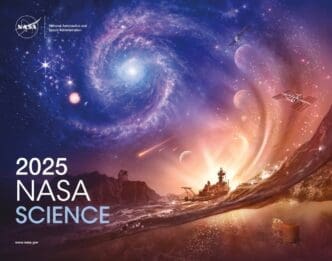NASA’s 2025 Science Calendar presents a captivating array of cosmic phenomena and explorations that continue to propel our understanding of the universe and our place in it. From extraordinary observations captured by citizen scientists to groundbreaking findings from spacecraft missions, the calendar showcases the relentless pursuit of knowledge at NASA.
In May 2024, the strongest geomagnetic storm in over twenty years unveiled a breathtaking aurora that illuminated skies worldwide, including areas where such displays are rare. Captured by an Aurorasaurus ambassador, this event highlighted the intersection of natural phenomena and citizen science.
Meanwhile, NASA’s Lucy spacecraft made a significant discovery during its passage through the asteroid belt. The mission, aimed at the Trojan asteroids near Jupiter, uncovered a contact binary satellite orbiting a larger asteroid for the first time. This celestial body was later named Selam, marking a new chapter in asteroid research.
As plans to return to the Moon advance, NASA focuses on understanding the biological impacts of space travel. Scientists have developed human brain models to analyze the effects of space radiation, aiming to mitigate potential health risks for astronauts on future missions.
NASA’s PACE satellite, operational since February 2024, gathers critical data on oceanic and atmospheric interactions. This information is vital for addressing challenges such as air pollution, harmful algal blooms, and climate change-induced shifts in marine ecosystems.
Winter on Mars brings with it the formation of carbon dioxide frost, stretching from the poles to mid-latitudes similar to southern Canada. Interestingly, small patches of this dry ice are found closer to the equator on shaded slopes, revealing dynamic seasonal shifts on the Red Planet.
Further exploration has merged data from the Chandra X-ray Observatory and the James Webb Space Telescope, investigating the Cassiopeia A supernova remnant. This collaboration has provided insights into a peculiar structure known as the ‘Green Monster,’ enhancing our understanding of stellar remnants.
In December 2023, the SUVI instrument on the GOES West satellite detailed solar activity, capturing images of plasma at extreme temperatures. These observations contribute valuable information about the sun’s behavior and its implications for space weather.
The James Webb and Hubble Space Telescopes offered a unique view of the spiral galaxy NGC 628, combining infrared and visible light to bring its features to life. These multi-spectrum observations are essential for unraveling the complexities of galactic formations.
The study of Arctic sea ice, as seen in images from NASA’s Gulfstream V aircraft, provides essential data on climate change impacts. These observations help scientists track changes in the polar environment, crucial for understanding global ice dynamics.
NASA’s Juno spacecraft delivered some of the clearest images of Jupiter’s moon Io in recent history. Captured during a flyby, these photographs highlight the moon’s volcanic features and enhance our comprehension of its geological activity.
A fascinating resemblance was found in a solder bead, mirroring aspects of our solar system’s processes, thus broadening insights into materials science.
In an atmospheric phenomenon, a Spritacular citizen scientist captured a sprite over Château de Beynac, offering a glimpse into these rare electrical displays that occur above storms.
The 2025 NASA Science Calendar encapsulates the ongoing endeavors in space exploration and scientific research, serving as a testament to the remarkable achievements and discoveries that continue to inspire curiosity and expand human knowledge. As we unlock new cosmic secrets, these advances remind us of the vastness of the universe and the endless possibilities that lie ahead.
Source: Science.nasa







